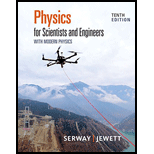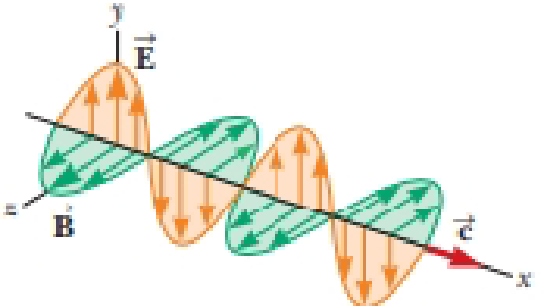
Physics for Scientists and Engineers with Modern Physics
10th Edition
ISBN: 9781337553292
Author: Raymond A. Serway, John W. Jewett
Publisher: Cengage Learning
expand_more
expand_more
format_list_bulleted
Textbook Question
Chapter 33.3, Problem 33.2QQ
What is the phase difference between the sinusoidal oscillations of the electric and magnetic fields in Figure 33.8? (a) 180° (b) 90° (c) 0 (d) impossible to determine

Expert Solution & Answer
Trending nowThis is a popular solution!

Students have asked these similar questions
Deduce what overvoltage is like in reversible electrodes.
pls help on these
pls help on these
Chapter 33 Solutions
Physics for Scientists and Engineers with Modern Physics
Ch. 33.1 - Prob. 33.1QQCh. 33.3 - What is the phase difference between the...Ch. 33.3 - Prob. 33.3QQCh. 33.5 - Prob. 33.4QQCh. 33.6 - Prob. 33.5QQCh. 33.7 - Prob. 33.6QQCh. 33.7 - Prob. 33.7QQCh. 33 - Prob. 1PCh. 33 - Prob. 2PCh. 33 - Prob. 3P
Ch. 33 - Prob. 4PCh. 33 - The distance to the North Star, Polaris, is...Ch. 33 - Prob. 6PCh. 33 - Prob. 7PCh. 33 - Prob. 8PCh. 33 - Prob. 9PCh. 33 - Prob. 10PCh. 33 - Prob. 11PCh. 33 - Prob. 12PCh. 33 - If the intensity of sunlight at the Earths surface...Ch. 33 - Prob. 14PCh. 33 - Prob. 15PCh. 33 - Review. Model the electromagnetic wave in a...Ch. 33 - Prob. 17PCh. 33 - Prob. 18PCh. 33 - Prob. 19PCh. 33 - Prob. 20PCh. 33 - Prob. 21PCh. 33 - The intensity of sunlight at the Earths distance...Ch. 33 - Prob. 23PCh. 33 - Prob. 24PCh. 33 - Prob. 25PCh. 33 - Prob. 26PCh. 33 - Extremely low-frequency (ELF) waves that can...Ch. 33 - A large, flat sheet carries a uniformly...Ch. 33 - Prob. 29PCh. 33 - Prob. 30PCh. 33 - Prob. 31PCh. 33 - Prob. 32PCh. 33 - Prob. 33APCh. 33 - Prob. 34APCh. 33 - Prob. 35APCh. 33 - Prob. 36APCh. 33 - Prob. 37APCh. 33 - One goal of the Russian space program is to...Ch. 33 - Prob. 39APCh. 33 - Prob. 40APCh. 33 - Prob. 41APCh. 33 - Prob. 42APCh. 33 - Prob. 43APCh. 33 - Prob. 44APCh. 33 - Review. (a) A homeowner has a solar water heater...Ch. 33 - Prob. 46APCh. 33 - Prob. 47APCh. 33 - Prob. 48APCh. 33 - Prob. 49APCh. 33 - Prob. 50CPCh. 33 - Prob. 51CP
Knowledge Booster
Learn more about
Need a deep-dive on the concept behind this application? Look no further. Learn more about this topic, physics and related others by exploring similar questions and additional content below.Similar questions
- 20. Two small conducting spheres are placed on top of insulating pads. The 3.7 × 10-10 C sphere is fixed whie the 3.0 × 107 C sphere, initially at rest, is free to move. The mass of each sphere is 0.09 kg. If the spheres are initially 0.10 m apart, how fast will the sphere be moving when they are 1.5 m apart?arrow_forwardpls help on allarrow_forwardpls help on thesearrow_forward
- pls help on all asked questions kindlyarrow_forwardpls help on all asked questions kindlyarrow_forward19. Mount Everest, Earth's highest mountain above sea level, has a peak of 8849 m above sea level. Assume that sea level defines the height of Earth's surface. (re = 6.38 × 106 m, ME = 5.98 × 1024 kg, G = 6.67 × 10 -11 Nm²/kg²) a. Calculate the strength of Earth's gravitational field at a point at the peak of Mount Everest. b. What is the ratio of the strength of Earth's gravitational field at a point 644416m below the surface of the Earth to a point at the top of Mount Everest? C. A tourist watching the sunrise on top of Mount Everest observes a satellite orbiting Earth at an altitude 3580 km above his position. Determine the speed of the satellite.arrow_forward
- pls help on allarrow_forwardpls help on allarrow_forward6. As the distance between two charges decreases, the magnitude of the electric potential energy of the two-charge system: a) Always increases b) Always decreases c) Increases if the charges have the same sign, decreases if they have the opposite signs d) Increases if the charges have the opposite sign, decreases if they have the same sign 7. To analyze the motion of an elastic collision between two charged particles we use conservation of & a) Energy, Velocity b) Momentum, Force c) Mass, Momentum d) Energy, Momentum e) Kinetic Energy, Potential Energyarrow_forward
- pls help on all asked questions kindlyarrow_forwardpls help on all asked questions kindlyarrow_forward17. Two charges, one of charge +2.5 × 10-5 C and the other of charge +3.7 × 10-6 C, are 25.0 cm apart. The +2.5 × 10−5 C charge is to the left of the +3.7 × 10−6 C charge. a. Draw a diagram showing the point charges and label a point Y that is 20.0 cm to the left of the +3.7 × 10-6 C charge, on the line connecting the charges. (Field lines do not need to be drawn.) b. Calculate the net electric field at point Y.arrow_forward
arrow_back_ios
SEE MORE QUESTIONS
arrow_forward_ios
Recommended textbooks for you
 Physics for Scientists and Engineers, Technology ...PhysicsISBN:9781305116399Author:Raymond A. Serway, John W. JewettPublisher:Cengage Learning
Physics for Scientists and Engineers, Technology ...PhysicsISBN:9781305116399Author:Raymond A. Serway, John W. JewettPublisher:Cengage Learning Principles of Physics: A Calculus-Based TextPhysicsISBN:9781133104261Author:Raymond A. Serway, John W. JewettPublisher:Cengage Learning
Principles of Physics: A Calculus-Based TextPhysicsISBN:9781133104261Author:Raymond A. Serway, John W. JewettPublisher:Cengage Learning
 Physics for Scientists and Engineers: Foundations...PhysicsISBN:9781133939146Author:Katz, Debora M.Publisher:Cengage Learning
Physics for Scientists and Engineers: Foundations...PhysicsISBN:9781133939146Author:Katz, Debora M.Publisher:Cengage Learning Physics for Scientists and EngineersPhysicsISBN:9781337553278Author:Raymond A. Serway, John W. JewettPublisher:Cengage Learning
Physics for Scientists and EngineersPhysicsISBN:9781337553278Author:Raymond A. Serway, John W. JewettPublisher:Cengage Learning Physics for Scientists and Engineers with Modern ...PhysicsISBN:9781337553292Author:Raymond A. Serway, John W. JewettPublisher:Cengage Learning
Physics for Scientists and Engineers with Modern ...PhysicsISBN:9781337553292Author:Raymond A. Serway, John W. JewettPublisher:Cengage Learning

Physics for Scientists and Engineers, Technology ...
Physics
ISBN:9781305116399
Author:Raymond A. Serway, John W. Jewett
Publisher:Cengage Learning

Principles of Physics: A Calculus-Based Text
Physics
ISBN:9781133104261
Author:Raymond A. Serway, John W. Jewett
Publisher:Cengage Learning


Physics for Scientists and Engineers: Foundations...
Physics
ISBN:9781133939146
Author:Katz, Debora M.
Publisher:Cengage Learning

Physics for Scientists and Engineers
Physics
ISBN:9781337553278
Author:Raymond A. Serway, John W. Jewett
Publisher:Cengage Learning

Physics for Scientists and Engineers with Modern ...
Physics
ISBN:9781337553292
Author:Raymond A. Serway, John W. Jewett
Publisher:Cengage Learning
What Are Electromagnetic Wave Properties? | Physics in Motion; Author: GPB Education;https://www.youtube.com/watch?v=ftyxZBxBexI;License: Standard YouTube License, CC-BY